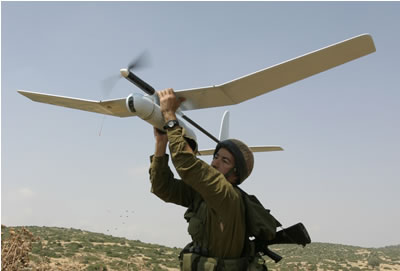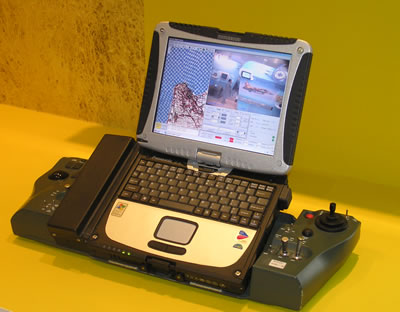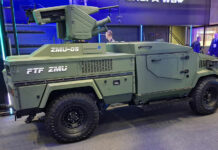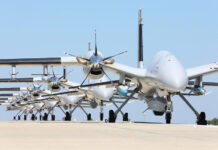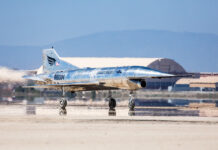Elbit has developed the Skylark miniature UAVs, a manpacked system designed for tactical close-range surveillance and reconnaissance missions, artillery fire adjustments as well as force protection and perimeter security.
The mini UAV is quickly assembled before the mission and is launched by hand. Recovery is performed by a deep stall maneuver, which lands the vehicle safely on a small inflatable cushion, at a pre-designated point. The cushion is designed to protect the payload on landing. The entire mission is flown autonomously, feeding real-time continuous video and telemetry data to the portable ruggedized ground station. Its wings and tail surfaces are constructed of a lightweight composites, the fuselage tubular boom is also made of composites.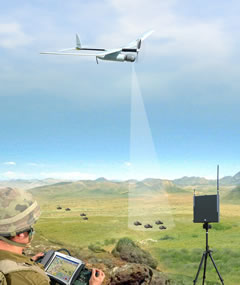
The avionics and payload systems are contained in a pod carried below the boom. The gimbaled payload utilizes a daylight CCD or an optional FLIR for night operation, which can be rotated by four gimbals. In February 2004 Elbit won an IDF Ground Forces Command contract to supply the Skylark for evaluation and testing as an organic UAV system, to be operated by infantry units.Skylark has since entered operational service with selected IDF units, used for operational testing and doctrine development and evaluation.During the Second Lebanon war in July-August 2006, Skylark mini-UAVs were operated by IDF units performing close-in reconnaissance missions in support of the ground forces, providing valuable real-time intelligence, due to their low acoustic and visual signatures, Skylarks were able to operate at very low altitude practically undetectable.
 In 2005 the Australian MOD selected the Skylark to support the deployment of Australian forces in Iraq. Six systems were procured and deployed to Southern Iraq. In September, 2006 Thales Canada announced it has been selected by the Department of National Defence Land Forces to deliver a mini-UAV system based on Elbit’s Skylark technology. France has also procured the system for its Special Forces. Sweden and the Netherlands are also evaluating the systems, operating small quantities bought for operational evaluation. By December 2008, the Israel Defense Forces has selected an enhanced version of Elbit System’s Skylark mini- UAV for operation at the battalion level.
In 2005 the Australian MOD selected the Skylark to support the deployment of Australian forces in Iraq. Six systems were procured and deployed to Southern Iraq. In September, 2006 Thales Canada announced it has been selected by the Department of National Defence Land Forces to deliver a mini-UAV system based on Elbit’s Skylark technology. France has also procured the system for its Special Forces. Sweden and the Netherlands are also evaluating the systems, operating small quantities bought for operational evaluation. By December 2008, the Israel Defense Forces has selected an enhanced version of Elbit System’s Skylark mini- UAV for operation at the battalion level.
The original Skylark I used a miniature gyro stabilized payload weighing only 500gr. The payload was developed by Elbit Systems specifically for MAV applications. It consists of a daylight color CCD. When fitted with night-camera, the payload’s weight doubles to one kilogram. Payload-vehicle integration enables simple and intuitive operation in holding position, as the payload “looks” at a designated point while the UAV circles above to maintain a continuous cover, and camera guide, where the user designates a target or rout to be followed by the payload and aircraft. Image obtained by the camera are overlaid on the integrated map situational display. The Skylark 1 LE uses a different payload called STAMP stabilized miniature payload developed by Controp, available in daylight, night, uncooled thermal and HD configurations.
The new Skylark 1LE configuration offers many enhancements over the original Skylark, primarily 50% increased endurance (3 hours), operational altitude (- 700 ft. to +3000 ft above or below the takeoff point), operational ceiling of 15,000 ft and extended mission radius of up to 15 km, (50 – 100% increase over the original model). The wing span has been increased by 70 cm to 2.9 meters and maximum gross takeoff weight increased by 600 gram from 6.1 (6.3 in the night mission configuration).
While the small UAV is simple to operate, as it is guided autonomously throughout the mission (even in GPS denied terrain) Elbit Systems is offering an optional integrated video simulator to improve training, enabling operators to better understand and plan a mission, based on realistic views of the expected target. Other optional enhancements include an auxiliary operating console, to be operated at the battalion command team.


